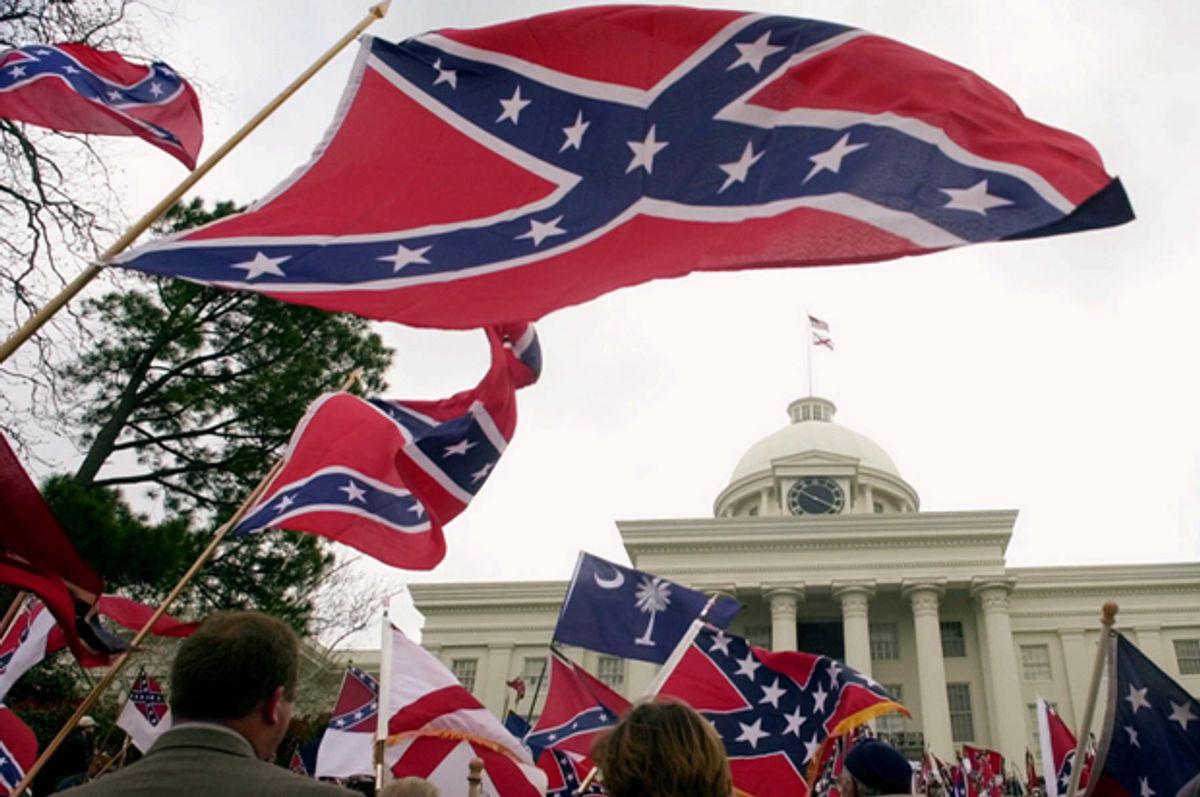I am a Southerner by both birth and heritage. I come from a long line of poor white cotton farmers on both sides of my family. Three of my four great-grandfathers fought in the Confederate Army. The fourth had been told by his parents that he could join the army when he turned 13; he was on his way from Texas to Virginia to do so when he met his brothers coming home on the road. They told him that Lee had surrendered and the war was over. My grandmother was a member of the United Daughters of the Confederacy and I was enrolled at the age of 6 in the Children of the Confederacy. I mention these credentials because of what I am about to say about the Confederate battle flag.
The flag that is causing such a furor was not “the Confederate flag,” as so many news reports have described it. It was a military flag, originally square in form, designed by William Porcher Miles, an aide to General P.G.T. Beauregard, after the first Battle of Manassas, because Beauregard thought that the Confederate national flag, which had a circle of white stars in a blue canton and three broad stripes, red, white, and red, was too easily confused with the Union flag in the smoke of battle. Miles’s battle flag was never approved by the Confederate Congress and never adopted as a national flag. It never flew over Confederate government offices, or over the Capitol at Richmond.
It was not even prominent among the symbols of the Lost Cause that helped create the myth of the noble suffering South during the years after the Civil War, nor was it celebrated during those years as a hallowed symbol of the Southern past, as apologists for it claim. According to University of Mississippi historian Allen Cabaniss, writing in The Encyclopedia of Southern Culture, it was seldom displayed at Confederate reunions or used by any of the societies of descendants of Confederate veterans. My grandmother’s United Daughters of the Confederacy chapter used the first national flag, the one that Beauregard thought could be confused with the Union flag, at their meetings, and she made me a small one out of silk to hang in my bedroom.
Cabaniss describes how the Confederate battle flag emerged “out of limbo” as a symbol of white supremacy and segregation during the Dixiecrat political campaign of 1948, when Strom Thurmond of South Carolina ran for president on a platform of states’ rights and segregation. Newspaper accounts of the States Rights Democratic Party convention in Birmingham, Alabama, describe delegates marching into the auditorium under Confederate battle flags as bands played “Dixie.” This set the stage for the adoption of the battle flag by the Ku Klux Klan and the White Citizens Councils across the South as a symbol of their racist opposition to integration. The first time I can remember seeing a picture of the battle flag carried in public was during the Clinton, Tennessee, race riot in 1956, when hooded Klansmen descended on the town and paraded down the main street under the flag.
Next month the Klan will rally at the South Carolina statehouse grounds under the Confederate battle flag. When it was at its peak, in the 1920s, the Klan’s members paraded under the American flag.
The fact is that in the 1950s and 1960s, the Confederate battle flag was hijacked and dishonored by racists and white supremacists who were opposed to the Federal government’s implementation of the 1954 Brown vs. Board of Education Supreme Court decision ending public school segregation. Two years after the decision, in 1956, the Georgia Legislature incorporated the battle flag into the state flag as a protest against integration. The battle flag was first raised over the South Carolina state Capitol on April 11, 1961, to mark the beginning of the Civil War Centennial; in March 1962 the Legislature voted to leave it there as a protest against the civil rights movement. Its 20th century symbolism is clear to anyone who examines the historical record, and it is not something to honor or revere.
In June 1865, two months after the Confederate surrender, a Catholic priest named Abram Joseph Ryan, a former Confederate Army chaplain, published a poem entitled “The Conquered Banner.” Its seven stanzas urged Southerners to accept defeat and furl their flags. The final stanza reads:
Furl that banner, softly, slowly!
Treat it gently – it is holy –
For it droops above the dead.
Touch it not – unfold it never,
Let it droop there, furled forever,
For its people’s hopes are dead.
The poem was once a standard recitation piece in Southern households, including my grandmother’s. The racists of the 1950s should have heeded Father Ryan’s advice. Now it is definitely time to furl that banner.

Shares